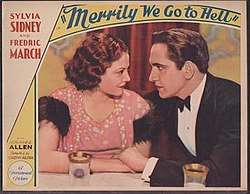Merrily We Go to Hell
Merrily We Go to Hell is a 1932 pre-Code film directed by Dorothy Arzner, and starring Fredric March and Sylvia Sidney. Its title is an example of the sensationalistic titles that were common in the pre-Code era.[2] Many newspapers refused to publicize the film because of its racy title.[3] The title is a line March's character says while making a toast.[4]
| Merrily We Go to Hell | |
|---|---|
 lobby card | |
| Directed by | Dorothy Arzner |
| Based on | I, Jerry, Take Thee, Joan (1931 novel) by Cleo Lucas |
| Starring | Sylvia Sidney Fredric March[1] |
| Cinematography | David Abel[1] |
| Edited by | Jane Loring |
Production company | |
| Distributed by | Paramount Publix Corp. |
Release date |
|
Running time | 78, 82 or 88 minutes[1] |
| Country | United States |
| Language | English |
March plays a man undone by alcoholism and adultery.[5] Sidney plays his wife who, when she discovers his adultery, begins an affair with another man (Cary Grant).[4] The film received a mixed review from The New York Times upon its release.[6]
Plot
Jerry Corbett (Fredric March), a Chicago reporter and self-styled playwright, meets heiress Joan Prentice (Sylvia Sydney) at a party and they begin dating. Jerry soon proposes to Joan, and even though his economic prospects are dim and he is an alcoholic, Joan accepts his marriage proposal, against the objections of her father (George Irving). Even though Jerry becomes heavily intoxicated just before their engagement party, ruining it, Joan stands by him. Jerry writes some plays which are rejected, and fights his alcohol addiction. He manages to sell a play and the couple travels to New York to watch the production. The star of the play turns out to be Jerry's former girlfriend, Claire Hampstead (Adrianne Allen), and on the premiere night he drinks heavily, becomes drunk, and mistakes Joan for Claire. Still, Joan stands by him. But, when Joan catches Jerry trying to sneak out to Claire's one night she kicks him out. The following day she tells him that they will have a "modern marriage" and that she intends to have affairs herself.
When Jerry is next seen, he is making a "Merrily we go to hell" toast with Claire. In turn, Joan and her date toast to the "holy state of matrimony–single lives, twin beds and triple bromides in the morning." Joan becomes pregnant and learns from her doctor that her health is poor. She tries to tell Jerry, but he is too occupied with Claire and she decides to move on. After he is unable to write a successful follow-up play, Jerry eventually realizes that he loves Joan, and regrets his behavior. He commits to sobriety, returns to Chicago, and works as a reporter again, but Joan's father keeps them apart. Jerry discovers Joan has given birth from a gossip columnist and goes to the hospital to see her. Joan's father tells him the baby day died two hours after his birth, that Joan is very ill, and that she does not want to see him ever again. However, Jerry sneaks into her room anyway, while Joan in pain is asking the nurse to send for Jerry, she has to see him. He discovers his distraught wife has been pleading to see him all along. A repentant Jerry pledges his love to her and they kiss.
Cast
- Sylvia Sidney as Joan Prentice
- Fredric March as Jerry Corbett
- Adrianne Allen as Claire Hempstead
- Richard "Skeets" Gallagher as Buck
- George Irving as Mr. Prentice
- Esther Howard as Vi
- Florence Britton as Charlcie
- Charles Coleman as [Richard] Damery
- Cary Grant as Charlie Baxter
- Kent Taylor as Greg Boleslavsky
- Robert Greig as Baritone Bartender (uncredited)
- Theresa Harris as Bathroom Attendant at Nightclub
Reception
Mordaunt Hall, film critic for The New York Times, gave the film a mixed review upon its release.[6] Hall believed the film was wildly funny in stretches, and described the acting by the two leads as "excellent", but believed the scenes in which March played intoxicated went nowhere, and that the script was lacking.[6] However, despite similar reviews, which often noted that it had been directed by a woman, the film was one of the more financially successful films that year.[7] Jessie Burns of Script criticised the casting of Frederic March in the film, finding him to be unconvincing, though thought that Adrianne Allen showed her "star" quality in her portrayal of an otherwise "artificial" character.[8]
References
Notes
- Merrily We Go to Hell at the American Film Institute Catalog
- Doherty. pg. 103
- Doherty. p. 108
- Merrily We Go to Hell, tcm.com, accessed October 12, 2010.
- Merrily We Go To Hell, Times Daily, July 8, 1932, accessed October 11, 2010.
- Hall, Mordaunt. Merrily We Go to Hell (1932) - "I, Jerry, Take Thee, Joan.", The New York Times, June 11, 1932, accessed October 12, 2010.
- Mayne, p. 59
- Deschner 1973, pp. 36-37.
Bibliography
- Deschner, Donald (1973). The Complete Films of Cary Grant. Citadel Press. ISBN 0-8065-0376-9.CS1 maint: ref=harv (link)
- Doherty, Thomas Patrick (1999). Pre-Code Hollywood: Sex, Immorality, and Insurrection in American Cinema 1930-1934. New York: Columbia University Press. ISBN 0-231-11094-4.
- Mayne, Judith (1994). Directed by Dorothy Arzner. Indiana University Press. ISBN 0-253-20896-3.